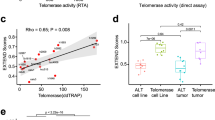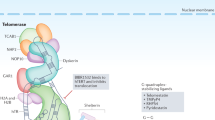Abstract
Rapid advances in our understanding of the molecular basis of cancer development and progression over the past three decades have led to the design of new potential cancer therapies. High throughput target validation and expression studies are expected to yield a powerful arsenal of new cancer treatments, but untangling the complex pathways underlying the major cancer phenotypes remains a significant challenge. A considerable body of evidence in recent years implicates deregulated expression of a single multi-component enzyme, telomerase, as a causative factor at the heart of immortalization in the vast majority of human tumors. This review highlights the potential of telomerase as a target for novel cancer therapies. The potential of exploiting the selectivity of the telomerase family of genes within cancer cells to develop gene therapy strategies is discussed, and the progress towards translating these novel therapeutics from the laboratory to the clinic is reviewed.
This is a preview of subscription content, access via your institution
Access options
Subscribe to this journal
Receive 12 print issues and online access
$209.00 per year
only $17.42 per issue
Buy this article
- Purchase on Springer Link
- Instant access to full article PDF
Prices may be subject to local taxes which are calculated during checkout



Similar content being viewed by others
References
Keith WN et al. (2001) Telomerase and cancer: time to move from a promising target to a clinical reality. J Pathol 195: 404–414
Keith WN et al. (2002) Telomerase-directed molecular therapeutics. Expert Rev Mol Med 2002: 1–25
Kim NW et al. (1994) Specific association of human telomerase activity with immortal cells and cancer. Science 266: 2011–2015
Masutomi K et al. (2000) Telomerase activity reconstituted in vitro with purified human telomerase reverse transcriptase and human telomerase RNA component. J Biol Chem 275: 22568–22573
Kim MM et al. (2001) A low threshold level of expression of mutant-template telomerase RNA inhibits human tumor cell proliferation. Proc Natl Acad Sci USA 98: 7982–7987
White LK et al. (2001) Telomerase inhibitors. Trends Biotechnol 19: 114–120
Lavelle F et al. (2000) Telomerase: a therapeutic target for the third millennium? Crit Rev Oncol Hematol 34: 111–126
Majumdar AS et al. (2001) The telomerase reverse transcriptase promoter drives efficacious tumor suicide gene therapy while preventing hepatotoxicity encountered with constitutive promoters. Gene Ther 8: 568–578
Takeda T (2003) Tumor-specific gene therapy for undifferentiated thyroid carcinoma utilizing the telomerase reverse transcriptase promoter. J Clin Endocrinol Metab 88: 3531–3538
Plumb JA et al. (2001) Telomerase-specific suicide gene therapy vectors expressing bacterial nitroreductase sensitize human cancer cells to the pro-drug CB1954. Oncogene 20: 7797–7803
Bilsland AE et al. (2003) Selective ablation of human cancer cells by telomerase-specific adenoviral suicide gene therapy vectors expressing bacterial nitroreductase. Oncogene 22: 370–380
Komata T et al. (2001) Treatment of malignant glioma cells with the transfer of constitutively active caspase-6 using the human telomerase catalytic subunit (human telomerase reverse transcriptase) gene promoter. Cancer Res 61: 5796–5802
Liu J et al. (2002) Cancer-specific killing by the CD suicide gene using the human telomerase reverse transcriptase promoter. Int J Oncol 21: 661–666
Koga S et al. (2001) FADD gene therapy using the human telomerase catalytic subunit (hTERT) gene promoter to restrict induction of apoptosis to tumors in vitro and in vivo. Anticancer Res 21: 1937–1943
Koga S et al. (2000) A novel telomerase-specific gene therapy: gene transfer of caspase-8 utilizing the human telomerase catalytic subunit gene promoter. Hum Gene Ther 11: 1397–1406
Komata T et al. (2001) A novel treatment of human malignant gliomas in vitro and in vivo: FADD gene transfer under the control of the human telomerase reverse transcriptase gene promoter. Int J Oncol 19: 1015–1020.
Gu J et al. (2002) A novel single tetracycline-regulative adenoviral vector for tumor-specific Bax gene expression and cell killing in vitro and in vivo. Oncogene 21: 4757–4764
Lin T et al. (2002) Targeted expression of green fluorescent protein/tumor necrosis factor-related apoptosis-inducing ligand fusion protein from human telomerase reverse transcriptase promoter elicits antitumor activity without toxic effects on primary human hepatocytes. Cancer Res 62: 3620–3625
Jacob D et al. (2004) Suppressing orthotopic pancreatic tumor growth with a fiber-modified adenovector expressing the TRAIL gene from the human telomerase reverse transcriptase promoter. Clin Cancer Res 10: 3535–3541
Gu J et al. (2002) hTERT promoter induces tumor-specific Bax gene expression and cell killing in syngenic mouse tumor model and prevents systemic toxicity. Gene Ther 9: 30–37
Huang TG et al. (2003) Telomerase-dependent oncolytic adenovirus for cancer treatment. Gene Ther 10: 1241–1247
Kim E et al. (2003) Ad-mTERT-Delta19, a conditional replication-competent adenovirus driven by the human telomerase promoter, selectively replicates in and elicits cytopathic effect in a cancer cell-specific manner. Hum Gene Ther 14: 1415–1428
Wirth T et al. (2003) A telomerase-dependent conditionally replicating adenovirus for selective treatment of cancer. Cancer Res 63: 3181–3188
Kawashima T et al. (2004) Telomerase-specific replication-selective virotherapy for human cancer. Clin Cancer Res 10: 285–292
Zou W et al. (2004) A novel oncolytic adenovirus targeting to telomerase activity in tumor cells with potent. Oncogene 23: 457–464
Lanson NA et al. (2003) Replication of an adenoviral vector controlled by the human telomerase reverse transcriptase promoter causes tumor-selective tumor lysis. Cancer Res 63: 7936–7941
Irving J et al. (2004) Conditionally replicative adenovirus driven by the human telomerase promoter provides broad-spectrum antitumor activity without liver toxicity. Cancer Gene Ther 11: 174–185
Wang J et al. (2003) Enhanced suicide gene therapy by chimeric tumor-specific promoter based on HSF1 transcriptional regulation. FEBS Lett 546: 315–320
Nettelbeck DM et al. (2000) Gene therapy: designer promoters for tumor targeting. Trends Genet 16: 174–181
Galanis E et al. (2001) Delivery systems intended for in vivo gene therapy of cancer: targeting and replication competent viral vectors. Crit Rev Oncol Hematol 38: 177–192
Kyo S and Inoue M (2002) Complex regulatory mechanisms of telomerase activity in normal and cancer cells: how can we apply them for cancer therapy? Oncogene 21: 688–697
Soder AI et al. (1998) Tumour specific regulation of telomerase RNA gene expression visualized by in situ hybridization. Oncogene 16: 979–983
Feng J et al. (1995) The RNA component of human telomerase. Science 269: 1236–1241
Guilleret I et al. (2002) The human telomerase RNA gene (hTERC) is regulated during carcinogenesis but is not dependent on DNA methylation. Carcinogenesis 23: 2025–2030
Muller M et al. (1998) Comparison of human telomerase RNA and telomerase activity in urine for diagnosis of bladder cancer. Clin Cancer Res 4: 1949–1954
Takakura M et al. (1999) Cloning of human telomerase catalytic subunit (hTERT) gene promoter and identification of proximal core promoter sequences essential for transcriptional activation in immortalized and cancer cells. Cancer Res 59: 551–557
Cong YS et al. (1999) The human telomerase catalytic subunit hTERT: organization of the gene and characterization of the promoter. Hum Mol Genet 8: 137–142
Wick M et al. (1999) Genomic organization and promoter characterization of the gene encoding the human telomerase reverse transcriptase (hTERT). Gene 232: 97–106
Zhao JQ et al. (1998) Cloning and characterization of human and mouse telomerase RNA gene promoter sequences. Oncogene 16: 1345–1350
Martin-Rivera L et al. (1998) Expression of mouse telomerase catalytic subunit in embryos and adult tissues. Proc Natl Acad Sci USA 95: 10471–10476
Greenberg RA et al. (1998) Expression of mouse telomerase reverse transcriptase during development, differentiation and proliferation. Oncogene 16: 1723–1730
Zhao JQ et al. (2000) Activation of telomerase RNA gene promoter activity by NF-Y, Sp1, and the retinoblastoma protein and repression by Sp3. Neoplasia 2: 531–539
Greenberg RA et al. (1999) Telomerase reverse transcriptase gene is a direct target of c-Myc but is not functionally equivalent in cellular transformation. Oncogene 18: 1219–1226
Groot-Wassink T et al. (2004) Noninvasive imaging of the transcriptional activities of human telomerase promoter fragments in mice. Cancer Res 64: 4906–4911
Vasey PA and Evans TRJ (2002) Principles of chemotherapy and drug development. In Treatment of Cancer, 103–129 (Eds Price P and Sikora K) London: Arnold Publishers
Gottesman MM (2003) Cancer gene therapy: an awkward adolescence. Cancer Gene Ther 10: 501–508
Palmer DH et al. (2004) Virus-directed enzyme prodrug therapy: intratumoral administration of a replication-deficient adenovirus encoding nitroreductase to patients with resectable liver cancer. J Clin Oncol 22: 1546–1552
Vasey PA et al. (2002) Phase I trial of intraperitoneal injection of the E1B-55-kd-gene-deleted adenovirus ONYX-015 (dl1520) given on days 1 through 5 every 3 weeks in patients with recurrent/refractory epithelial ovarian cancer. J Clin Oncol 20: 1562–1569
Acknowledgements
Research in the author's laboratory is supported by Cancer Research UK, and Glasgow University.
Author information
Authors and Affiliations
Corresponding author
Ethics declarations
Competing interests
The authors declare no competing financial interests.
Glossary
- BYSTANDER EFFECT
-
Tumor regression when a fraction of the tumor mass is genetically modified
Rights and permissions
About this article
Cite this article
Keith, W., Bilsland, A., Hardie, M. et al. Drug Insight: cancer cell immortality—telomerase as a target for novel cancer gene therapies. Nat Rev Clin Oncol 1, 88–96 (2004). https://doi.org/10.1038/ncponc0044
Received:
Accepted:
Issue Date:
DOI: https://doi.org/10.1038/ncponc0044
This article is cited by
-
Combining old and new concepts in targeting telomerase for cancer therapy: transient, immediate, complete and combinatory attack (TICCA)
Cancer Cell International (2023)
-
Telomerase and cancer therapeutics
Nature Reviews Cancer (2008)
-
Targeting telomerase for cancer therapeutics
British Journal of Cancer (2008)
-
Amplification of telomerase (hTERT) gene is a poor prognostic marker in non-small-cell lung cancer
British Journal of Cancer (2006)
-
Reviews and comment from the nature publishing group
Nature Reviews Cancer (2005)



